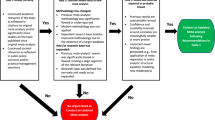Abstract
Experienced executives frequently try to modify the risky situations they face in order to make them more favorable rather than simply choosing from among available decision options. This article investigates several types of risk adjustments such as trying to influence the situation through bargaining and spending resources, gathering information, developing new options, and consulting one's superiors. A theoretical framework is presented that characterizes different types of adjustments and relates them to variables such as perceived risk, perceived control, perceived responsibility, decisiveness, and risky choice. The framework is tested using experienced decision makers who respond to four simulated risky business decisions.
Similar content being viewed by others
References
Adler, S. (1980), “Risk Making Management,” Business Horizons 23, 11–14.
Baird, I.S. and Thomas, H. (1985), “Toward a Contingency Model of Strategic Risk Taking,” Academy of Management Review 10, 230–243.
Cox, D.F. and Rich, S.U. (1964), “Perceived Risk and Consumer Decision Making,” Journal of Marketing Research 1, 32–39.
Ehrlich, I. and Becker, G.S. (1972). “Market Insurance, Self-Insurance, and Self-Protection,” Journal of Political Economy 80, 623–648.
Fischhoff, B. (1984). “Setting Standards: A Systematic Approach to Managing Public Health and Safety Risks,” Management Science 30, 823–843.
Fishburn, P.C. (1984). “Foundations of Risk Measurement: Risk as Probable Loss,” Management Science 30, 396–406.
Frederiksen, N., Saunders, D.R. and Wand, B. (1957) “The In-basket Test,” Psychological Monographs: General and Applied 71, 438.
Gooding, A.E. (1975). “Quantification of Investors Perceptions of Common Stocks—Risk and Return Dimensions,” Journal of Finance 30, 1301–1316.
Higbee, K.L. and Streufert, S. (1969). “Perceived Control and Riskiness,” Psychonomic Science, 17, 105–106.
Hohenemser, C., Kates, R.W. and Slovic, P. (1983). “The Nature of Technological Hazard,” Science 220, 378–384.
Jackson, D.N., Hourany, L. and Vidmar, N.J. (1972). “A Four-Dimensional Interpretation of Risk Taking,” Journal of Personality 40, 483–501.
Janis, I. and Mann, L. (1977). Decision Making: A Psychological Analysis of Confict, Choice, and Commitment. New York: Free Press.
Kahneman, D., Slovic, P. and Tversky, A. (1982). Judgment Under Uncertainty: Heuristics and Biases. London: Cambridge University Press.
Keyes, R. (1985). Chancing It. Boston: Little, Brown.
Kogan, N. and Wallach, M.A. (1964). Risk Taking: A Study of Cognition and Personality. New York: Holt, Rinehart and Winston.
Liverant, S. and Scodel, A. (1960). “Internal and External Control as Determinants of Decision Making under Conditions of Risk,” Psychological Reports 7, 59–67.
Luce, D. (1980). “Several Possible Measures of Risk,” Theory and Decision 12, 217–228.
MacCrimmon, K.R. and Wehrung, D.A. (1984). “The Risk In-Basket,” Journal of Business 57, 367–387.
MacCrimmon, K.R. and Wehrung, D.A. (1986). Taking Risks: The Management of Uncertainty. New York: The Free Press.
March, J.G. and Shapira, Z. (1987). “Managerial Perspectives on Risk and Risk Taking,” Management Science 33, 1404–1418.
Oldman, D. (1974). “Chance and Skill: A Study of Roulette,” Sociology 8, 407–426.
Payne, J.W. (1973). “Alternative Approaches to Decision Making under Risk: Moments versus Risk Dimensions,” Psychological Bulletin 80, 439–453.
Ross, I. (1974). “Perceived Risk and Consumer Behavior: A Critical Review,” in: M.J. Schlinger (ed.), Advances in Consumer Research, Vol. II. Urbana: Association for Consumer Research.
Savage, L.J. (1954). The Foundations of Statistic. New York: Wiley.
Schoemaker, P. (1980). Experiments on Decisions under Risk: The Expected Utility Hypothesis. Boston: Kluwer-Nijhoff Publishing.
Schoemaker, P. (1989). “Preferences for Information on Probabilities vs. Prizes: The Role of Risk Taking Attitudes,” Journal of Risk and Uncertainty 2, 37–60.
Slovic, P. (1962). “Convergent Validation of Risk Taking Measures,” Journal of Abnormal and Social Psychology 65, 68–71.
Slovic, P. (1964). “Assessment of Risk Taking Behavior,” Psychological Bulletin 61, 220–233.
Strickland, L., Lewici, R.J. and Katz, A.M. (1966). “Temporal Orientation and Perceived Control as Determinants of Risk Taking,” Journal of Experimental Social Psychology 2, 143–151.
Zellner, A. (1962). “An Efficient Method of Estimating Seemingly Unrelated Regressions and Tests for Aggregation Bias,” 57, 348–368.
Additional information
University of British Columbia
Chinese University of Hong Kong
This study was supported by grants from The Centre of International Business Studies at The University of British Columbia, The Chinese University of Hong Kong, and the Social Sciences and Humanities Research Council of Canada.
Rights and permissions
About this article
Cite this article
Wehrung, D.A., Lee, KH., Tse, D.K. et al. Adjusting risky situations: A theoretical framework and empirical test. J Risk Uncertainty 2, 189–212 (1989). https://doi.org/10.1007/BF00056137
Issue Date:
DOI: https://doi.org/10.1007/BF00056137




